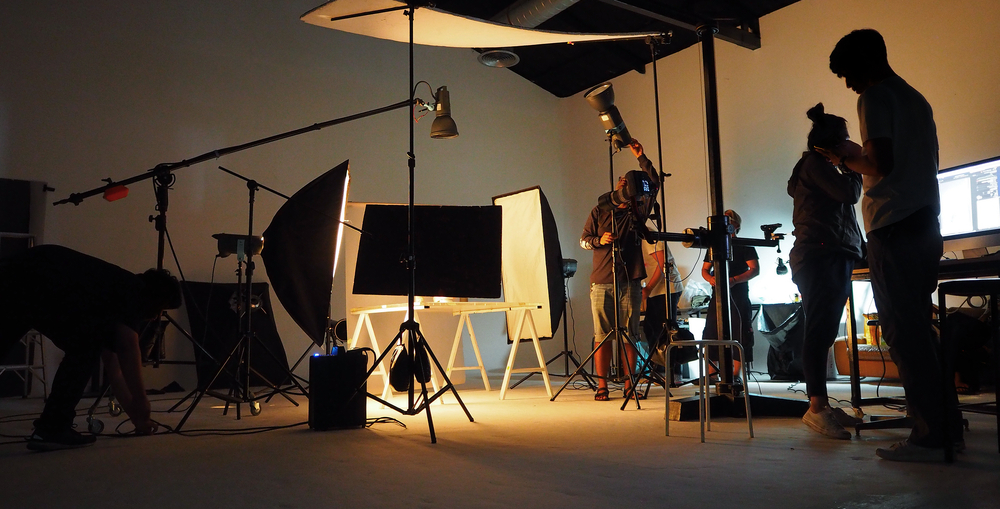
What your body language says about you
Understand the importance of gestures and how they are perceived by others.

For some time now, videos have become the main communication media worldwide. Just to give you an idea, YouTube, the main audiovisual platform on the planet, accumulates over 1 billion hours of watched videos daily.
Given the importance of this type of media, more and more people are searching for video content in order to learn new skills or simply for entertainment.
If you find yourself on the other side of this situation and consider yourself to be a content producer, you already know that there is a lot of territory to cover in terms of body language and public speaking techniques, right?
Therefore, we’ve created this very comprehensive guide to talk about one of the most important elements for any communicator: body language.
Do you want to know what your gestures say about you and how to control this aspect of your communication?
In this guide, you will see:
What is body language, anyway?

There’s also a huge myth regarding these figures, because many people misinterpret them by assigning them to the message’s content.
If this were true, when watching a foreign movie without subtitles, all you’d need to do would be analyze the characters’ body language in order to understand 93% of what they are saying, which is not possible.
In fact, Albert Mehrabian defends that it is necessary to have a consistency between what is being said and how it is said, in order to convey the message as best as possible.
Within this logic, a salesperson who maintains constant visual eye contact, for example, is able to convey much more confidence and assurance to customers that those who don’t look people in the eye, which demonstrates deceit – even if both are saying the exact same words.
According to the psychologist, professor and expert on the subject, Albert Mehrabian, body language is a form of non-verbal communication in which we communicate by means of gestures, facial expressions and our posture.
Body language was around before verbal language and is considered extremely important for our communication.
According to Mehrabian, we convey our feelings and ideas in the following proportion: 7% verbal, 38% vocal (tone of voice) and 55% facial (through our expressions).
Could you have imagined that body language makes up more than 50% of our communication? Pretty surprising, right?
That’s why it’s so important. Albert Mehrabian defends that it is necessary for what is being said and how it is said to be consistent to convey the message as best as possible.
Based on this logic, a salesperson who maintains constant visual eye contact with clients, for example, is able to convey much more confidence and assurance to them than those who don’t look people in the eye.
In short, body language consists of a set of gestures, postures and other forms of expression by our body, which not only help, but are also a good part of your interpersonal communication.
What your body language says about you
Well-applied and practiced body language works as a confirmation of the message we are conveying. In other words, when we behave in conformity with the idea we mean to project, the message itself can be understood more easily and clearly.
In this manner, more than the content itself, body language is responsible for making our emotions and feelings known. Gestures, body posture, tone of voice and the speed in which we speak, or even, how we move while we communicate.
There are several types of emotions that can be detected through non-verbal communication. Fear, insecurity, anger, boredom, mistrust, dissimulation, among others, are merely a few examples of emotional variations transmitted by a simple gesture.
Let’s imagine the following situation:
You have just been hired to speak on the subject you really master to a group of top entrepreneurs. Undoubtedly, this is an intimidating scenario on its own.
However, you already know that the way to behave will make all the difference in winning over (or not) that audience that, at first, might be hostile and complicated.
Therefore, the best thing when starting your lecture is to smile and use a firm and deep tone of voice to show that you master the subject, and at the same time, welcome those who are listening.
It might seem simple, but this type of posture, combined with other body language practices, are the difference between a successful lecture and a failed presentation.
In the worst-case scenario, lecturers that speak too fast, look away from the audience and who frequently run their hands through their hair for example, demonstrate insecurity, anxiety and lack of mastery of the subject.
Observe that we didn’t mention the lecture’s content at any moment.
It can be strictly the same for both examples. However, the perception between one and the other changes completely how people receive the message, simply by considering opposing body language.
Why use body language?
This is a tricky question, because it’s not as if we truly have an alternative for it. After all, our body will transmit non-verbal signals regardless of our will.
In this sense, the most important thing is to know the different forms of body language and how to use them in your favor.
Therefore, don’t think of body language as an option or something to be added to your communication.
It is as essential as speech, and unlike the latter, which is restricted to our choices, it will manifest whether we want to or not.
So, focus on your efforts to learn how your body communicates and control each aspect of this language, thus being able to clearly convey your ideas.
Is there such a thing as negative body language?

You’re probably trying to think of body language techniques to better convey your messages and win over your audience, right?
But before this, you need to understand that there are different aspects in this type of non-verbal communication.
While the successful use of different gestures and postures help make our communication be seen in a positive light by the counterpart, understanding that the opposite may also happen is crucial.
This is the negative body language, responsible for incalculable damage to communication.
Negative body language
Often, when we interact with someone, regardless of the context, we may transmit negative body language without even realizing it.
While facial expressions usually easily “give away” our feelings, gestures as subtle as the position of the hands or even the place towards which our knees are pointed can convey unpleasant meanings.
Examples of negative body language
There are a few classic postures and gestures that translate feelings of discomfort, impatience or insecurity.
If they are undesirable in a personal relationship, just imagine the damage they can cause in professional interactions?
Below, we’ve listed a few examples of gestures that you should avoid so as not to convey negative body language.
Hand over the mouth
Covering the mouth with a hand is a classic and clear gesture of omitting or lying. In other words, when someone isn’t telling the truth, they usually cover their own mouth.
This type of gesture can present variations, such as frequently running one’s hands over the lips, touching one’s chin at length or repeatedly or even putting objects in front of one’s mouth, such as glasses, mugs, pens, etc.
Lips pressed together
The act of pressing one’s lips together demonstrates a denial of what is being said.
Usually, when someone doesn’t want to give their opinion, say what they think or take a stand, their lips are pressed together.
It’s a variation of the hand over the mouth gesture, despite denoting a denial or omission and not necessarily a need to lie.
Vague gaze
One’s gaze is one of the key elements of body language.
When we don’t focus our gaze on the person we are talking to, we convey an image of insecurity and lack of clarity in what is being said.
Usually confused with shyness, this type of posture can be translated as a search for a mental image.
By shifting our eyes from our focus, we are searching for something to provide support to our discourse, which denotes insecurity.
Frowning
This gesture is usually perceived by the person receiving the message.
In other words, if at any moment you are speaking and the person you are talking to frowns, this is a warning sign, because it’s not a good gesture.
Frowning indicates a high level of tension, nervousness and especially doubt. It can be an indication that your message isn’t being received clearly.
Restricted arms and hands
Hands behind the back, close to the upper body and crossed feet indicating a position of little trust.
This type of body language gives clear signs of discomfort, which may suggest lack of candor and intimacy in a conversation.
Types of body language
So far, you’ve seen a few examples of body language and the differences between positive and negative body language, in addition to its effects on your life.
Now, we’ll move on to a subject that’s a bit more technical. It’s time for you to learn the existing types of body language.
There are five categories used to classify non-verbal communication:
Kinesics
Kinesics is related to literal body language, referring to hand gestures and facial expressions.
Looking in people’s eyes, smiling, gestures, postures, and anything that involves our bodies is considered kinesics.
Proxemics
Proxemics is related to the use of the space that surrounds us. In other words, how far or close we are to the person with whom we are communicating.
This concept is applied to in-person and physical interaction. For example, if you want to have a more intimate conversation with someone, you’ll be closer to them when talking and you might even place a hand on them sometimes.
Unlike when you speak to a crowd, where you’re farther away from your audience and thus need to raise your tone of voice and use other expressions.
Paralanguage
Paralanguage is about vocalization: tone of voice, volume, intonation, etc.
Have you ever noticed that it’s super essential to adjust your voice to the emotions you want to convey when communicating?
Even if you’ve never noticed that you’ve definitely experienced confusion communicating with someone via text message. For example, you sent a message with a friendly tone but the receiver interpreted it as aggressive or rude.
This is because our voices are essential for clarity when communicating.
The same content can change meaning if spoken with a different intonation, volume or tone of voice.
Haptics
Haptics is related to touch. It’s applied in interpersonal communications, such as when greeting or communicating more intimately with someone.
An example of when to be careful with regard to haptics is when dealing with different cultures.
In the US, it’s common for people to greet each other with a handshake and nothing else.
In Brazil, on the other hand, people are used to greeting each other with hugs and kisses.
And in countries like India and Japan, it’s common to not even touch other people. People greet each other from a distance.
Physical characteristics
Do appearances matter? For body language, yes. Physical characteristics are part of our communication and are related to appearance, clothing and physical aspects.
When interacting with someone or an audience, physical characteristics are the first thing about you they’ll see. Remember that saying: “first impressions are the most lasting”?
So, take care of your appearance and dress appropriately for the impression you want to make on the people with whom you communicate.
This is an important part of your body language to communicate well in professional presentations and job interviews, for example, among other situations.
All these classifications that we presented help understand how it’s possible to categorize each type of body language and to be aware of the importance of each one.
Body language in video recording
If the introduction to this guide was captivating, you probably want to know how to apply the body language techniques when you record your videos, right?
Well, the time has come!
When we’re producing audiovisual content, the key element connecting the audience and us is invariably our image. And this is why body language is so important for this type of activity.
Below, we’ll talk about 5 tips on how to behave better in front of the cameras and produce content that will win over your audience with the ideal body language.
Check them out:
1. Don’t look tired
In addition to body language itself, our appearance also says a lot about the content we wish to convey in our videos.
Therefore, appearing before the cameras looking tired, with dark circles under your eyes and looking discouraged is the worst choice you can make.
An exhausted presenter conveys a sense of boredom and weariness, demonstrating how much they’d rather be somewhere else.
Think about the last good motivational talk you watched. Do you remember it?
Well then, the speaker was likely confident and cheerful. After all, how can you motivate others if you’re looking tired?
2. Control your tone of voice
Excess creates problems in any aspect of our life, and the use of our voice is not an exception.
Therefore, be careful with extremes of volume regarding your tone of voice.
Recording a video in a very low voice, even when using a quality microphone, gives a sense of boredom and apathy.
On the other hand, if you speak too loudly, you’ll annoy people and make them anxious, which can make people quickly abandon your video.
The best choice is to alternate voice volume according to your content, emphasizing important moments and maintaining a calm tone of voice when necessary.
3. Don’t overdo gestures
While hand gestures help make your video more dynamic, increasing viewer interest in what you’re talking about, excessive hand gestures can easily become distracting for your audience.
Also, avoid crossing your arms, which convey an idea of superiority and arrogance.
Behaving like an educator, or even like someone who is the standard in a given subject, doesn’t agree with an arrogance at all.
4. Look at the camera with confidence
When we record a video, we have to keep in mind that the camera lens represents our entire audience. That’s why it’s essential to have the posture of “looking them in the eye”, favoring the connection between you and your viewer.
Thus, avoid looking to the sides, demonstrating insecurity, and downwards. In addition to transmitting a posture of inferiority and lack of confidence, you might also disrupt the audio capturing, especially if it is done by using a lavalier microphone under your clothing.
Speaking anything while looking down also gives the impression of lack of importance of the subject, in addition to causing boredom and disinterest in those who are watching the video.
5. Straighten up your posture
A conveyed message or idea either gains or loses credibility due to all the aspects that we’ve listed so far. But there is one, which is very important and easy to correct with practice, turning it into a habit: an upright posture.
Being over with drooping shoulders is a classic demonstration of insecurity.
If you present yourself to your audience in this manner, this will be the first thing people will notice.
Therefore, always remember to stand up straight, without overdoing it with a forced posture. This way, you’ll demonstrate confidence, mastery of the subject and security in what you’re saying. In addition, it also helps in preserving your health and your back.
6. Speak slowly and clearly
The rhythm of your speech conveys a lot of your emotions. If you speak too fast, your viewers will think you’re nervous.
Not to mention that talking at a fast pace can result in lack of clarity, disconnection, confusion, among other problems that hinder your communication.
Therefore, focus on maintaining a good pace, so that viewers can understand the content, but also don’t speak too slowly so as not to bore your audience.
If you feel nervous, take a deep breath, take breaks, but don’t give up!
Practice and train beforehand so you don’t have to rush because you underestimated the time it would take to perform or record the video.
Another tip is to train your intonation to learn the best moments to slow down, emphasize and speak more assertively.
7. Smile!
Smiling is an act of connection, it conveys sympathy and keeps communication light.
Even if the content you’re presenting is serious, you don’t have to be completely serious or serious all the time.
Opening your presentation with a smile can make all the difference in breaking the ice and gaining your audience’s attention.
Methods to improve your performance on video
When we choose to record videos, we are choosing to convey an idea, teach something or even attract a target audience for our business.
Therefore, it is essential that you abandon all of your limiting beliefs and invest in better body language techniques to increase your recordings’ performance.
With this in mind, we’ve selected a few essential tips so your videos can be more successful.
Plan everything
A recorded video is always an opportunity to plan beforehand, everything that will happen when you hit the “record” button.
Therefore, never underestimate the importance of having a script.
More than having one script per video, you should have a monthly and weekly plan, creating a routine of creative production.
This way, when it’s time to record, you’ll master the content, the steps of the process and the video events completely.
All that’s left to do now is concentrate on what you will say and how you will say it.
Avoid the bad days
You know those days in which everything goes wrong and nothing seems to get solved? They are more common than you think!
If you have created a prior plan and a recording routine, you can afford to avoid such bad days.
When we communicate in a bad mood, feeling discouraged, sad or tired, we are transmitting these feelings to the audience.
However brilliant you are as an actor, there will always be a gesture that is overlooked, revealing to the viewer that not everything is as well as it seems.
Check your equipment and location
You already know how to control your tone of voice, varying it according to the importance of the topics being covered. But it is also important to eliminate any types of external interference that force you to unintentionally change your voice’s volume.
Remember to choose a suitable location and the right time of day to record your video.
If possible, invest in a studio with acoustic treatment or at least, record at quieter times and places.
Never read your script while recording
One of the biggest mistakes in communication is to show lack of mastery over the subject you are presenting to the audience.
Who of us has never given a presentation at school by reading the notes written the day before and felt extremely automated and stifled?
It’s the same with the recording of videos.
You need to have a script, because it contains the information that will be conveyed in the recording, which are so important in order to persuade the audience to buy your idea.
However, your script can never be more than a guide, so it is important that you not read it during the video.
Don’t put information in it that should be memorized!
The ideal scenario is that you become familiar with the text beforehand and master everything that will be said even before you start recording.
This way, you convey confidence and show your audience that you know the subject well, presenting yourself as competent.
On the other hand, reading from a script in front of the camera kills all the naturalness of your speech, in addition to stifling your body language, which must act together with your verbal language.
Never chew gum
Gum can help you a lot to reduce stress, but it also portrays an extremely negative image when you’re recording a video.
In addition to being rude and show a lack of care with your self-image, chewing gum also conveys an idea of arrogance and lack of importance of the subject.
There’s no problem in chewing gum, as long as you do it before or after you record. Never during the recording!
Make sure everything’s in order
Before you start recording, make sure that everything is working well, from you equipment to your wardrobe and accessories.
The last thing you want is to be interrupted because of a silly problem, losing your train of thought and draining your confidence when it’s time to speak.
Watch your wardrobe
Transmitting a video message means working with our image. Therefore, we need to take care so that distractions don’t occur, especially when we can easily control them.
The wardrobe is extremely important in this sense.
When in doubt, choosing more discrete outfits, such as T-shirts without patterns or more neutral colors.
The choice must take into consideration your need to draw your audience’s attention to the idea and not to the outfit you’re wearing.
In addition, a discrete outfit avoids body language habits, which may happen when we are using a jacket with several pockets, a blouse with a zipper or any other elements that we can play with unconsciously while we speak.
Choose your best side
Everyone has one side of their face they like better than the other.
This dominant profile must be selected when recording your videos, which helps in your self-confidence and will make you better appreciate the results of the recordings.
Of course, you don’t have to be completely sideways, but just use this preferred side as the dominant side when in front of the cameras.
In addition, you will also be projecting more confidence to your audience.
The art of speaking
As you can see, communication is a very complex activity, which involves several other aspects besides speaking.
Gestures, one’s posture and the tone of voice… all these elements are part of our body language, which is capable of influencing much more than you imagine!
Regardless of this fact, don’t let your fear of being your best self in front of the cameras become an obstacle to start recording videos or even speak in public.
As the old saying goes: Practice makes perfect!
Therefore, start recording or even give lectures or presentations, and over time, you’ll notice how your body language will adapt to your speech.
Whenever you feel the need, come back to this guide to recall the tips that we’ve selected here and make sure you get more practice with these 5 tips to improve your public speaking skills!





